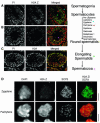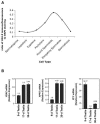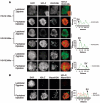The X and Y chromosomes assemble into H2A.Z-containing [corrected] facultative heterochromatin [corrected] following meiosis
- PMID: 16809775
- PMCID: PMC1592715
- DOI: 10.1128/MCB.00519-06
The X and Y chromosomes assemble into H2A.Z-containing [corrected] facultative heterochromatin [corrected] following meiosis
Erratum in
- Mol Cell Biol. 2006 Oct;26(19):7343
Abstract
Spermatogenesis is a complex sequential process that converts mitotically dividing spermatogonia stem cells into differentiated haploid spermatozoa. Not surprisingly, this process involves dramatic nuclear and chromatin restructuring events, but the nature of these changes are poorly understood. Here, we linked the appearance and nuclear localization of the essential histone variant H2A.Z with key steps during mouse spermatogenesis. H2A.Z cannot be detected during the early stages of spermatogenesis, when the bulk of X-linked genes are transcribed, but its expression begins to increase at pachytene, when meiotic sex chromosome inactivation (MSCI) occurs, peaking at the round spermatid stage. Strikingly, when H2A.Z is present, there is a dynamic nuclear relocalization of heterochromatic marks (HP1beta and H3 di- and tri-methyl K9), which become concentrated at chromocenters and the inactive XY body, implying that H2A.Z may substitute for the function of these marks in euchromatin. We also show that the X and the Y chromosome are assembled into facultative heterochromatic structures postmeiotically that are enriched with H2A.Z, thereby replacing macroH2A. This indicates that XY silencing continues following MSCI. These results provide new insights into the large-scale changes in the composition and organization of chromatin associated with spermatogenesis and argue that H2A.Z has a unique role in maintaining sex chromosomes in a repressed state.
Figures








Similar articles
-
Expression and epigenomic landscape of the sex chromosomes in mouse post-meiotic male germ cells.Epigenetics Chromatin. 2016 Oct 27;9:47. doi: 10.1186/s13072-016-0099-8. eCollection 2016. Epigenetics Chromatin. 2016. PMID: 27795737 Free PMC article.
-
Monoubiquitylation of H2A.Z distinguishes its association with euchromatin or facultative heterochromatin.Mol Cell Biol. 2007 Sep;27(18):6457-68. doi: 10.1128/MCB.00241-07. Epub 2007 Jul 16. Mol Cell Biol. 2007. PMID: 17636032 Free PMC article.
-
Postmeiotic sex chromatin in the male germline of mice.Curr Biol. 2006 Apr 4;16(7):660-7. doi: 10.1016/j.cub.2006.01.066. Curr Biol. 2006. PMID: 16581510
-
[Meiotic inactivation of sex chromosomes in mammals].Genetika. 2010 Apr;46(4):437-47. Genetika. 2010. PMID: 20536013 Review. Russian.
-
[Heterochromatin, gene position effect and gene silencing].Genetika. 2003 Feb;39(2):187-201. Genetika. 2003. PMID: 12669414 Review. Russian.
Cited by
-
Gametogenesis: A journey from inception to conception.Curr Top Dev Biol. 2019;132:257-310. doi: 10.1016/bs.ctdb.2018.12.006. Epub 2019 Jan 8. Curr Top Dev Biol. 2019. PMID: 30797511 Free PMC article. Review.
-
Mammalian sperm nuclear organization: resiliencies and vulnerabilities.Basic Clin Androl. 2016 Dec 21;26:17. doi: 10.1186/s12610-016-0044-5. eCollection 2016. Basic Clin Androl. 2016. PMID: 28031843 Free PMC article.
-
Y chromosome functions in mammalian spermatogenesis.Elife. 2021 Oct 4;10:e67345. doi: 10.7554/eLife.67345. Elife. 2021. PMID: 34606444 Free PMC article. Review.
-
Poised chromatin and bivalent domains facilitate the mitosis-to-meiosis transition in the male germline.BMC Biol. 2015 Jul 22;13:53. doi: 10.1186/s12915-015-0159-8. BMC Biol. 2015. PMID: 26198001 Free PMC article.
-
Expression and functionality of histone H2A variants in cancer.Oncotarget. 2014 Jun 15;5(11):3428-43. doi: 10.18632/oncotarget.2007. Oncotarget. 2014. PMID: 25003966 Free PMC article. Review.
References
-
- Abbott, D. W., M. Laszczak, J. D. Lewis, H. Su, S. C. Moore, M. Hills, S. Dimitrov, and J. Ausio. 2004. Structural characterization of macroH2A containing chromatin. Biochemistry 43:1352-1359. - PubMed
-
- Armstrong, S. J., M. A. Hulten, A. M. Keohane, and B. M. Turner. 1997. Different strategies of X-inactivation in germinal and somatic cells: histone H4 underacetylation does not mark the inactive X chromosome in the mouse male germline. Exp. Cell Res. 230:399-402. - PubMed
-
- Byrne, J. A., S. Simonsson, P. S. Western, and J. B. Gurdon. 2003. Nuclei of adult mammalian somatic cells are directly reprogrammed to oct-4 stem cell gene expression by amphibian oocytes. Curr. Biol. 13:1206-1213. - PubMed
Publication types
MeSH terms
Substances
LinkOut - more resources
Full Text Sources
